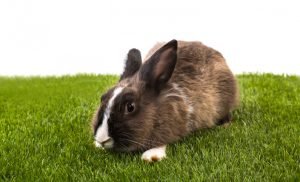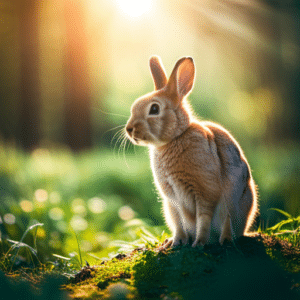In the fascinating world of biology, there are often misconceptions that need to be debunked, and such is the case with our furry friends – rabbits. Many of us have been led to believe that rabbits are rodents, but this couldn’t be further from the truth. In this blog post, we will delve into the world of these lovable creatures, exploring their distinct characteristics, habits, and care needs that set them apart, and most importantly, why they are classified as mammals and not rodents. Get ready for an intriguing journey as we unravel the true nature of rabbits.
An Introduction to Mammals: Where Rabbits Fit In

To understand the relationship between rabbits and mammals, we must first delve into what makes an animal a mammal. Mammals have many defining traits – they are warm-blooded creatures with fur or hair and typically give birth to live young. They also produce milk in order to feed their offspring, and have complex brains that allow them to display unique behaviors.
Rabbits are unique mammals with many unique traits. For one, they have a different digestive system than other mammals. Additionally, unlike rodents, rabbits have four incisor teeth that continually grow throughout their lifetimes. This means that in order for them to stay healthy and fit a rabbit’s diet, they must chew on things constantly in order to keep these teeth at an appropriate length.
What Makes Rabbits Different from Rodents?
Now that we understand what makes a mammal, let’s move on to rodents. Unlike mammals, rodents have large front teeth and small eyes and ears. They mostly have hairless tails and are omnivores – meaning they eat both plant-based and animal-based foods. Rabbits, however, are obligate herbivores, meaning they must feed on a predominantly plant-based diet in order for their bodies to remain healthy.
Another major difference between how rabbits eat and rodents is that rabbits have different digestive systems than other mammals, which means that they must be fed differently. Rabbit digestion begins with the consumption of hay or grass, which is then digested by the cecum, also known as the “fermentation chamber.” This process helps rabbits to extract the necessary nutrients and calories that they need from their food. Rodents, on the other hand, do not possess this same digestive system and therefore must be fed differently than most rabbits in order to stay healthy.
Insights into Rabbit Anatomy: Unique Digestive Systems
So, what makes a rabbit’s digestive system special? Well, in addition to the cecum that stores and ferments food before it is digested, rabbits also have ileocecal valves which help them break down their food more efficiently. This valve separates the small intestine from the large intestine and helps keep harmful bacteria out of the small intestine, allowing the rabbit to absorb more nutrients from their food.
These unique characteristics of the digestive system also mean that rabbits should not be fed in the same manner as mice or rats. They must have a diet that consists of high-fiber hay and grass, along with fresh vegetables such as dark leafy greens like kale and spinach. It is also important to avoid feeding your rabbit grains and cereals, as these can be difficult for wild rabbits and their bodies to process.

The Dental Distinguisher: How Incisors Separate Rabbits from Rodents
Another unique trait of rabbits is their four incisor teeth – two on the top and two on the bottom. Unlike rodents, these never stop growing, which means that they must be kept at an appropriate length or else oral health issues may arise. To ensure your rabbit’s teeth remain healthy, it is important to provide them with chewing materials such as hay, wood sticks fresh grass, or chew toys.
In addition to keeping your rabbit’s teeth healthy, providing them with materials to chew on also allows them to express their natural behaviors and keeps them mentally stimulated. This is extremely important in keeping rabbits happy and healthy!
A Peek into Rabbit’s Diet: The Herbivorous Mammals
Now that we understand the unique characteristics of rabbits and why they are classified as mammals, let’s take a look at their diet. Rabbits should always have access to fresh grass and hay, which will keep their teeth healthy while also helping them digest properly. In addition to this, you can provide your rabbit with a variety of fresh leafy greens such as kale, spinach, and romaine lettuce. These are excellent sources of vitamins and minerals that will help keep your rabbit healthy.
It is also important to keep a consistent feeding schedule for your rabbit in order to maximize digestion and ensure their dietary needs are being met. You should feed them at the same time each day and avoid sudden changes in their diet as this can cause digestive problems.
How To Nurture Your Pet Rabbit: Comprehensive Care Guide
Rabbits are incredibly unique creatures, and they require specialized care in order to stay healthy. In addition to providing them with an appropriate and varied diet, you should also make sure their living environment is clean and free of harmful toxins or chemicals. Additionally, rabbits need plenty of exercise in order to remain fit and active – this is especially important for indoor or elderly rabbits.
Providing them with a safe and secure space to explore, along with interactive toys to keep their minds stimulated, will ensure that they remain happy and healthy.
Finally, it is important to keep your rabbit’s nails trimmed in order to avoid scratches or torn fur when they are playing. Additionally, you should check for signs of illness regularly such as changes in eating habits, unusual discharge or lumps, and any change in behavior.
As you can see, while rabbits have many superficial similarities with rodents and other small mammals, they are also unique creatures that deserve specialized care.

The Clockwork Of Rabbit’s Life: Reproduction, Babies, and Lifespan
Rabbits are known for their short gestation period and high reproductive rate. A female rabbit can give birth to a litter of between four and twelve babies within only 30 days! As soon as these young baby rabbits, called “kits”, are born they will need to be cared for diligently in order to ensure that they thrive. The mother rabbit will nurse her kits for up to a month until they are weaned and ready to start exploring the world.
When it comes to the lifespan of rabbit breeds, rabbits can live anywhere from 8-12 years depending on their breed and overall healthiness. In order to keep your rabbit happy and healthy throughout its life, it is important to provide them with the correct diet and plenty of exercise.
Overall, rabbits are incredibly unique creatures that require specialized care and attention in order to stay happy and healthy. By providing your rabbit with the correct diet, exercise, and a clean living environment you can ensure that they remain vibrant and full of life for many years to come!
Understanding the Conservation Status of Rabbits: Our Role in Their Survival
Unfortunately, wild rabbit populations are steadily declining due to deforestation, climate change, and other human activities. To help protect these amazing creatures, it is important to understand their habitat needs and be mindful of our own actions.
One way we can do this is by supporting conservation efforts that promote the preservation of natural habitats for rabbits. This could include owning pet rabbits, participating in local conservation projects or donating to organizations that are dedicated to protecting these animals.
Moreover, we can also spread awareness about the importance of rabbit conservation by educating our peers and family about their unique characteristics, needs, and habitats. By taking action we can help ensure that wild and domestic rabbits remain a part of our lives for many more generations to come!
Frequently Asked Questions (FAQs) about Rabbits as Mammals
Are rabbits mammals?
Yes, rabbits are mammals. They have a special digestive system that requires them to eat high-fiber hay and grass, along with fresh vegetables like dark leafy greens. Additionally being land mammals, they also have four incisor teeth that never stop growing.
Which group of mammals is a rabbit?
Rabbits belong to the Lagomorpha order, which includes hares and several species of pikas. They are also part of the family Leporidae, along with hares and other rabbit relatives.
Do rabbits need companionship?
Yes, rabbits need companionship in order to stay healthy and happy. They enjoy the presence of other rabbits and should always be kept in pairs or larger groups. Additionally, they can also form strong bonds with humans if given the opportunity!
How long do rabbits live?
The average lifespan of a rabbit is 8-12 years depending on their breed and overall health. To ensure that your rabbit lives a long and healthy life, it is important to provide them with the proper diet, exercise, and living environment. Additionally, regular check-ups with a veterinarian can help identify any potential health issues before they become serious.
Conclusion
Rabbits are amazing creatures that deserve our utmost respect and admiration. With their unique characteristics and dietary needs, we must ensure that we provide them with the best care we can in order to keep them healthy and happy. Moreover, it is also important to be mindful of our own actions when it comes to conservation efforts for wild rabbits, as this helps ensure that these incredible animals have a place in our lives for many more generations to come!
By understanding the complexities of caring for rabbits, we can all work together to ensure their continuing place in our lives. With awareness and education, we can help promote the preservation of their natural habitats and ensure that these amazing creatures remain part of our lives for years to come!
So let’s all do our part to make sure rabbits and social animals are provided with the care they need, and show them the love and respect they deserve!



